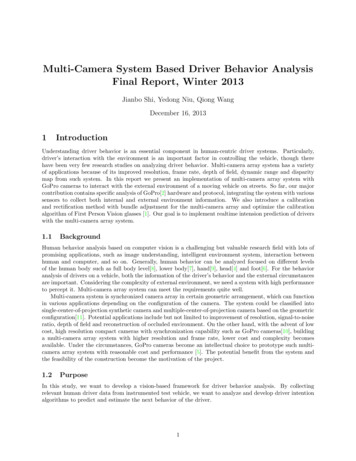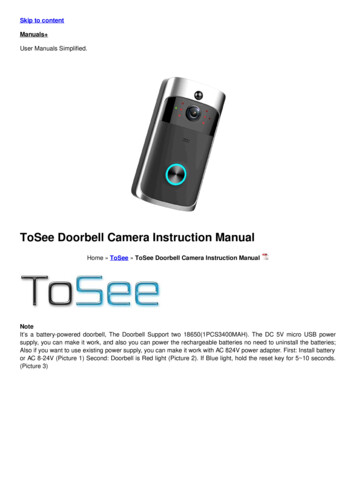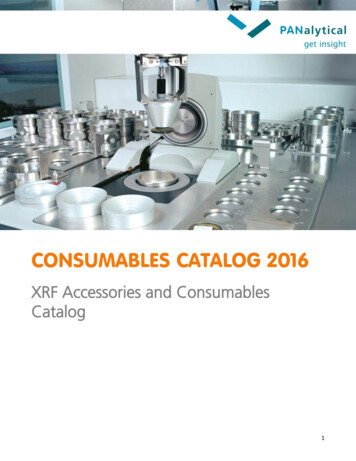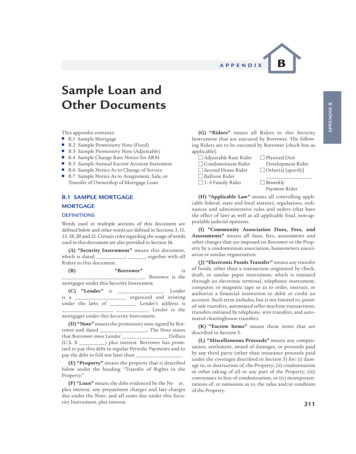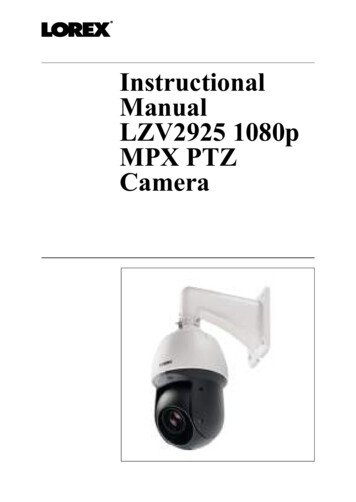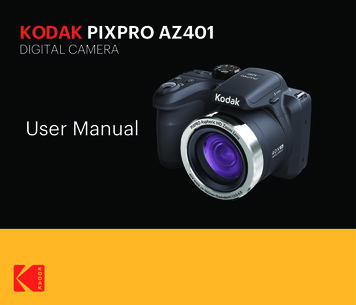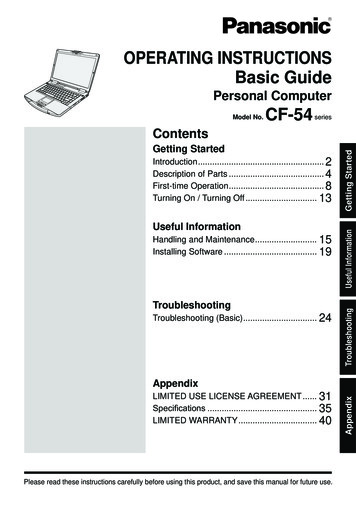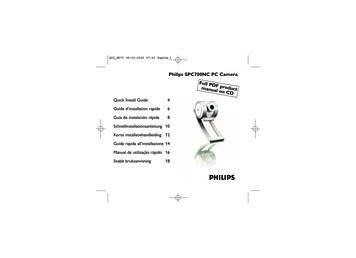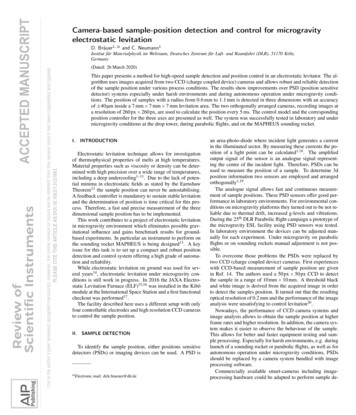
Transcription
Camera-based sample-position detection and control for microgravityelectrostatic levitationD. Bräuer1, a) and C. Neumann1This is the author’s peer reviewed, accepted manuscript. However, the online version of record will be different from this version once it has been copyedited and typeset.PLEASE CITE THIS ARTICLE AS DOI:10.1063/1.5121883Institut für Materialphysik im Weltraum, Deutsches Zentrum für Luft- und Raumfahrt (DLR), 51170 Köln,Germany(Dated: 26 March 2020)This paper presents a method for high-speed sample detection and position control in an electrostatic levitator. The algorithm uses images acquired from two CCD (charge coupled device) cameras and allows robust and reliable detectionof the sample position under various process conditions. The results show improvements over PSD (position sensitivedetector) systems especially under harsh environments and during autonomous operation under microgravity conditions. The position of samples with a radius from 0.6 mm to 1.1 mm is detected in three dimensions with an accuracyof 40 µm inside a 7 mm 7 mm 7 mm levitation area. The two orthogonally arranged cameras, recording images ata resolution of 260 px 260 px, are used to calculate the position every 5 ms. The control model and the correspondingposition controller for the three axes are presented as well. The system was successfully tested in laboratory and undermicrogravity conditions at the drop tower, during parabolic flights, and on the MAPHEUS sounding rocket.I.INTRODUCTIONElectrostatic levitation technique allows for investigationof thermophysical properties of melts at high temperatures.Material properties such as viscosity or density can be determined with high precision over a wide range of temperatures,including a deep undercooling1–11 . Due to the lack of potential minima in electrostatic fields as stated by the EarnshawTheorem12 the sample position can never be autostabilising.A feedback controller is mandatory to sustain stable levitationand the determination of position is time critical for this process. Therefore, a fast and precise measurement of the threedimensional sample position has to be implemented.This work contributes to a project of electrostatic levitationin microgravity environment which eliminates possible gravitational influence and gains benchmark results for groundbased experiments. In particular an instrument to perform onthe sounding rocket MAPHEUS is being designed13 . A keyissue for this task is to set up a compact and robust positiondetection and control system offering a high grade of automation and reliability.While electrostatic levitation on ground was used for several years14 , electrostatic levitation under microgravity conditions is still work in progress. In 2016 the JAXA Electrostatic Levitation Furnace (ELF)15,16 was installed in the Kibōmodule at the International Space Station and a first functionalcheckout was performed17 .The facility described here uses a different setup with onlyfour controllable electrodes and high resolution CCD camerasto control the sample position.II.SAMPLE DETECTIONTo identify the sample position, either positions sensitivedetectors (PSDs) or imaging devices can be used. A PSD isa) Electronicmail: dirk.braeuer@dlr.dean area-photo-diode where incident light generates a currentin the illuminated sector. By measuring these currents the position of a light point can be calculated1,18 . The amplifiedoutput signal of the sensor is an analogue signal representing the centre of the incident light. Therefore, PSDs can beused to measure the position of a sample. To determine 3dposition information two sensors are employed and arrangedorthogonally1,19 .The analogue signal allows fast and continuous measurement of sample positions. These PSD sensors offer good performance in laboratory environments. For environmental conditions on microgravity platforms they turned out to be not reliable due to thermal drift, increased g-levels and vibrations.During the 25th DLR Parabolic flight campaign a prototype ofthe microgravity ESL facility using PSD sensors was tested.In laboratory environment the devices can be adjusted manually for each experiment. Under microgravity on parabolicflights or on sounding rockets manual adjustment is not possible.To overcome those problems the PSDs were replaced bytwo CCD (charge coupled device) cameras. First experienceswith CCD-based measurement of sample position are givenin Ref. 14. The authors used a 50 px 50 px CCD to detectthe sample in a range of 10 mm 10 mm. A threshold blackand white image is derived from the acquired image in orderto detect the samples position. It turned out that the resultingoptical resolution of 0.2 mm and the performance of the imageanalysis were unsatisfying to control levitation20 .Nowadays, the performance of CCD camera systems andimage analysis allows to obtain the sample position at higherframe rates and higher resolution. In addition, the camera system makes it easier to observe the behaviour of the sample.This allows for better and faster equipment testing and sample processing. Especially for harsh environments, e.g. duringlaunch of a sounding rocket or parabolic flights, as well as forautonomous operation under microgravity conditions, PSDsshould be replaced by a camera system bundled with imageprocessing software.Commercially available smart-cameras including imageprocessing hardware could be adapted to perform sample de-
This is the author’s peer reviewed, accepted manuscript. However, the online version of record will be different from this version once it has been copyedited and typeset.PLEASE CITE THIS ARTICLE AS DOI:10.1063/1.51218832tection. The focus on the system presented here is the flexibility to easily customize it for different detection scenarios.Additionally, the system needs to fit in a rocket payload withrestrictions in size and weight. The complete ESL facility onMAPHEUS has a length of 1200 mm, a diameter of 390 mm,and a mass of 95 kg13 . The use of individual small camerasin combination with image processing on the existing controlcomputer gives great benefit.Hence, the current setup of the newly developed microgravity electrostatic levitator utilises two Basler acA640-120uccameras connected via USB3.0 to a mini-ITX computer.Within the current setup 260 px 260 px at 200 fps are usedto represent a field of 7 mm 7 mm. We aim for using higherframe-rate cameras in the future. This enhancement will allowto investigate smaller samples with lower mass, which will accelerate faster in the electrical field.To make use of the acquired images for positioning control, a real-time image analysis is necessary to determine thesample position. Using a 200 fps acquisition hardware, the algorithm needs to perform several steps to derive the sampleposition from the camera image within 5 ms.First the image needs to be acquired from the camera buffer.This process depends mainly on the camera linkage and thedevice driver. The current setup allows for a bandwidth of upto 300 MB/s per channel.Depending on the contrast in the image, the detectionshould recognise if the sample is present. This step is especially needed in autonomous environments to automaticallyload the next sample and start a new measurement cycle.For lower temperature range a background illumination isneeded to offer sufficient contrast for the sample detection algorithm. For higher temperatures the illumination needs to beswitched off to see the bright sample on a dark background.These cases need to be identified by the algorithm.In the next step the algorithm calculates the sample position. This part needs to be robust with respect to sample size,position and shape. For example it needs to find fast movingsamples, which no longer appear as a spherical object withclear border (motion blur) to offer a chance for the controllerto react properly.III.ALGORITHMThere are multiple algorithms available to detect circularcontours in images. The most common ones are based onthe Hough Transformation21 . To find a circle in a greyscalepicture, an edge detection needs to be performed first. Therefore, the first order image derivatives are calculated. It is doneby applying an operator (for comparison of different operators see Ref. 22) to each pixel of an image. The two imagederivatives need to be combined to one greyscale image thenhighlighting the edges of the source image. For each detectededge pixel it is determined if it fulfils the circle equation. If itis fulfilled, the element in the parameter space x, y, r is voted.The highest voted elements are likely to define a circle in theimage21 .This algorithm can easily be used to find all circles with different radii in one single image. The efficiency of the HoughTransformation depends mainly on the edge detection algorithm and the predefined parameter space. After the replacement of the PSDs by CCDs first tests with commercial detection algorithms based on Hough Transformation were performed. The results show a good detection rate when a precise edge of the sample can be found. The detection fails forimages containing motion blur. Further tests showed, the provided algorithms lack of performance when used for feedbackcontrol. Especially, if there are multiple objects in the acquired image, the algorithm tries to perform a circle detectionfor each. This approach results in varying detection rates andit cannot be guaranteed that the positions are send in real-timeto the feedback controller. The detection of a single levitating sample is a better-defined task. At any given time there isonly one sample which needs to be identified. Furthermore,this sample is the solitary object within the detection rangeand has an elliptical shape. Paying attention to those preconditions, a much more specific sample detection algorithm wasdeveloped.Fig. 1 shows one example for the detection process foran unheated sample with a diameter of 1.6 mm in front ofan illuminated background. In Fig. 1a the image acquiredfrom the camera is shown. The detection range has a sizeof 240 px 240 px; so there remains a border of 10 px at eachside of the image.In a first step the algorithm needs to test if background illumination is turned on. Therefore, the average grey valueof the left border area (240 px 10 px) is calculated. If thegrey value is lower than the threshold of 127, the algorithmassumes a bright sample in front of a dark background andthe image gets inverted for further tasks. In the given example the average value is higher than the threshold, so theimage remains unmodified for further processing. In parallel, to identify the detection mode, the border is cropped fromthe image. Then the remaining detection area is divided intosquares of 15 px 15 px. For each of the squares the sum of allcontained pixel values is computed resulting in a 16 16 matrix. Fig. 1b shows those sums normalised to 8 bit greyscale.Since there is considered only one major object, the darkestsquare represents a part of the sample. This step ensures thatsmaller objects in the detection region like the foil in the lowerleft corner or inhomogeneity in the illumination are excludedfrom the sample detection. Furthermore, the difference between the minimum and maximum in the intensity matrix isused to identify whether a sample is present at all or is considered lost from levitation by checking against a predefinedminimum contrast.The centre of the identified square marks a random pixelwithin the borders of the sample. It represents an estimationof the sample position in the image. Consequently, the algorithm starts from this position to search for the border of thesample in four directions. The search range is two times thedefined maximum sample radius (see Fig. 1c). The border detection is now performed by an edge detection on pixel-basis.Therefore, the first derivative in four directions is calculated.The highest gradient in each of the four directions defines one
This is the author’s peer reviewed, accepted manuscript. However, the online version of record will be different from this version once it has been copyedited and typeset.PLEASE CITE THIS ARTICLE AS DOI:10.1063/1.51218833FIG. 1. Different steps performed by the sample detection software to find an unheated sample ( 1.6 mm) in front of an illuminatedbackground. (a) Image acquired from camera system, (b) Grey-value sums of the 15 px 15 px regions scaled to 8-Bit, (c) Range to detect theborder of the sample based on the lowest sum of grey values, (d) Detected edges identified by highest grey-value gradients in each direction,(e) Calculated centre of levitating sample, (f) Estimated sample-shape based on the calculated radiuspixel at the edge of the sample. The detected points from theexample are highlighted in Fig. 1d.From these four points the coordinates of the samples centreis calculated by averaging horizontal and vertical coordinates,respectively (Fig. 1e). Within the current setup, the centre canbe detected with a spatial resolution of 27 µm in each direction. The uncertainty results from the border detection andcan be estimated to 1.5 px which corresponds to 40 µm.Finally, this algorithm is applied to each of the two cameras. This results in the three dimensional sample position,which is represented by the three coordinates of the samplecentre. These values are transmitted to the feedback controllerto stabilise the sample position. The sample loss informationis forwarded to the sequence control and will trigger feedingin the next sample.In addition the sample radius can be estimated by calculating the average distance between the sample centre and thedetected border points. At present it is used to check the valueagainst a predefined limit to proof the identified object probably is the sample. The estimated sample-shape based on thecalculated radius is shown in Fig. 1f and confirms the detectedsample centre.The detection might be influenced by the relation betweensample position and camera focus, irregular shape and rota-tion of a solid sample, and by light reflections on the surface.All these disturbances can be neglected, for an incandescent,liquid sample close to the centre of the electrode system.For the system used here, the algorithm needs to complete in 5 ms for both cameras. In addition to the steps described above, the image sequences should be stored on a harddisk drive for later analysis and be displayed live on the userscreen. The described algorithm is implemented in NI LabVIEW 2017 using the IMAQdx libraries. The calculated sample position is encoded and sent via a RS232 interface to thefeedback controller.The algorithm is able to perform more than 4000 cycles/susing one core of an Intel i7 processor. It offers enough scopefor future utilisation of faster camera systems and therebyfaster control algorithms and better observation of sample.IV.CONTROL MODELTo implement a suitable controller for stabilising the sample position it is necessary to find a control model for theelectrostatic levitator. For laboratory systems using five controllable and one grounded electrodes a model is describedin Refs. 1 and 19. The ELF facility also uses six electrodes
This is the author’s peer reviewed, accepted manuscript. However, the online version of record will be different from this version once it has been copyedited and typeset.PLEASE CITE THIS ARTICLE AS DOI:10.1063/1.51218834Coulomb’s law. For the resulting acceleration of the sample,the fields of all electrodes can be calculated as the superposition of the four fields. In addition, the calculation of the electrical field needs to consider the image charges on each electrode. For the rod electrodes, the positions of those chargesare inside the electrodes. For a sample position in the originthe superposition of the electrical fields of the image chargesneutralises.The resulting non-linear differential equation, describingthe movement of the charged sample in the electrostatic field,is given in Eq. (2). QEi is the charge of the electrode, εR therelative permittivity, ε0 the vacuum permittivity and r the position vector in the field. a r̈ FIG. 2. Electrode system of the microgravity electrostatic levitatorwith four separate electrodes to control the three-dimensional position of the levitated sample24 . In the current setup, the distance between the centres of the electrodes is 10 mm and the electrodes havea diameter of 3 mm.arranged orthogonally17,23 . In all those cases the control system can be separated into three one-dimensional problems. InRef. 14 a tetrahedral electrode-system using four controllersis presented. This setup requires a conversion between theCartesian camera-coordinates and the electrode positions. Allmentioned configurations cannot offer accessibility from allsides to the levitation area.A new electrode system24 , using only four electrodes wasdeveloped to meet the environmental conditions of microgravity. The setup allows the direct usage of the Cartesian cameracoordinates for the control system and offers full accessibility to the levitating sample from all six planes. In order togain stable control of the levitating sample inside this electrode system, a new control model needs to be formulated.The outputs of the system model are the three spatial coordinates x, y, z in mm of the sample position. The inputs arethe voltages of the four electrodes UX0Z0 ,UX1Z0 ,UY 0Z1 ,UY 1Z1in V. Fig. 2 shows the geometric conditions in the electrodesystem model with a sample in the origin.The sample is considered as a point with an electricalcharge of qP in A s and a mass m in kg. If it is exposed tothe electrical field E of a point electrode, motion results fromelectrostatic, inertial, gravitational, and frictional forces.Under microgravity conditions and using a vacuum chamber, the gravitational and frictional forces can be neglected.The acceleration a of the sample can be calculated by Eq. (1). a qP Em4QEi riqP 4πε0 εR m i 1 ri 3(2)Eq. (2) uses the charges of the electrodes as model input.Using high-voltage amplifiers, it is only possible to controlthe potential of the electrodes but not the charges. Both parameters correlate linearly.The controller is needed to stabilise the sample positionin the centre position between the electrodes. It meansthe setpoint for the desired position is constant. Considering Eq. (2) and a possible steady gravitational force, theelectric charges of the electrodes need to be constant toachieve an unstable equilibrium. A combination of sample position x0 , y0 , z0 and the voltages on the electrodesU0,X0Z0 ,U0,X1Z0 ,U0,Y 0Z1 ,U0,Y 1Z1 is defined as the operatingpoint of the system. In ideal circumstances it is identical tothe unstable equilibrium. For controller design, the nonlinearmodel should be linearised around this point using first orderTaylor series.The resulting linear model for the sample movementby the electrostatic field is given in Eq. (3).Inthese equations the positions x, y, z and the voltages uX0Z0 , uX1Z0 , uY 0Z1 , uY 1Z1 describe the deviations fromthe predefined operating point. The directions x, y and z aswell as the indices of the potentials u refer to Fig. 2. P and Kare linear factors resulting from constants in Eq. (2) and fromthe linearisation. ẍ Px x Kx ( uX0Z0 uX1Z0 ) ÿ Py y Ky ( uY 0Z1 uY 1Z1 ) z̈ Pz z Kz (( uX0Z0 uX1Z0 ) ( uY 0Z1 uY 1Z1 ))(3)The linearisation shows good approximation in the range of 2 mm around the operating point along each axis. Considering the radius of the used samples from 0.6 mm to 1.1 mmit is enough to calculate a controller for stabilising the sampleposition.(1)For the controller model, the electrodes are considered aspoint charges with position in the middle of each rod electrode. The electric field of each electrode can be calculated byV.CONTROLLERThe model developed in the previous section is the basis forthe controller implementation. In Ref. 19 a gain scheduling
This is the author’s peer reviewed, accepted manuscript. However, the online version of record will be different from this version once it has been copyedited and typeset.PLEASE CITE THIS ARTICLE AS DOI:10.1063/1.51218835controller for electrostatic levitator on ground is presented.The controller uses an estimation of the sample charge toadapt the control parameters. This estimation needs a constant gravitational force and is not applicable for microgravity conditions. In addition, the existing electrostatic levitationfacilities described in Refs. 15 and 19 use five or six controllable electrodes and for each axis the electrodes are separated.In the specific microgravity setup24 , only four electrodes arepresent. The developed controller needs to share electrodesto control the sample position in the three axes as shown inEq. (3).According to the unstable, linear model presented inEq. (3), a PID controller for each axis is used for the microgravity electrostatic levitator.The differential part is necessary to obtain a stable closedloop feedback control. The levitating sample needs to be inthe middle of the electrode system as shown in Fig. 2 to allowproper heating and temperature measurement. Therefore, anintegral action in the controller is required.With Eq. (3) and the standard PID-controller equation, theclosed control loop can be calculated. Studies with a swinging sample were used to adjust the unknown parameters ofthe linearised model. In combination with the closed loopequation, the controller parameters can be calculated to gainstability and robustness for the sample positioning. The outputs of the three PID controllers are three differential voltages ux , uy and uz . To calculate the output of each highvoltage-amplifier, they have to be portioned among the fourelectrodes and the operating point needs to be added. Thecorresponding equations are presented in Eq. 4.UX0Z0 U0,X0Z0 0.5 ux 0.25 uzUX1Z0 U0,X1Z0 0.5 ux 0.25 uzUY 0Z1 U0,Y 0Z1 0.5 uy 0.25 uzUY 1Z1 U0,Y 1Z1 0.5 uy 0.25 uz(4)The control algorithm is implemented on a National Instruments CompactRIO system with a Virtex-5 LX 110 FPGA(Field Programmable Gate Array) running at 500 Hz. Thecontrol software is written in NI LabVIEW using the FPGAToolbox. The sample position is received by the FPGA fromthe detection computer as a four byte array via serial interface.In this array, three bytes represent the sample position in thedetection range of 240 px for three axes. The fourth byte indicates the frame end and includes information about statusof background illumination and possibly lost samples. If nosample is detected, the controller uses the positions from theprevious iteration.To gain the most current position, the last four bytes in thebuffer are analysed. The controller runs faster than the sample detection cameras. If the camera was not able to send anew sample position, the controller continues with the previous one. The received positions in pixels are converted todeviations from the centre of the electrode system in mm.The FPGA calculates the potential differences for each ofthe three axes using the time discrete version of the PIDcontroller. Then outputs for the four amplifiers are calculated.In the next step, the voltage is limited to the respective maxi-mum output of the amplifiers. The last step is the calculationof the control voltage by dividing the limited output by thegain factor.The analogue voltage output is realised using the high speedNational Instruments C-series module 9263 with an accuracyof 16 bit. In addition, the measured positions and the calculated output are transferred to the host system for data loggingusing FPGA FIFOs. After receiving a predefined number ofconsecutive information on a lost sample, the host system isstarting to load and process the next one.VI.PERFORMANCE TESTSFor microgravity experiments, all electrodes are operatingin the same voltage range of 3 kV. For ground experiments,the two amplifiers connected to the bottom electrodes are replaced to offer up to 20 kV for lifting the sample. Additionally, the sample release method differs between microgravityand laboratory. In microgravity, the sample is hold betweentwo rods and released by pulling both rods apart (see Fig. 3).It takes up to 3 frames for the rods to move out of the sample detection area. During this time, the rods may disturb thesample detection and the position controller cannot be used.Assuming a free fall, in those 15 ms, the sample would movemore than 1 mm, which is one third of the levitation area. Thecontroller directly needs to apply a high voltage on the lowerelectrodes to catch the falling sample. If the sample is not sufficiently charged it will get lost. Tests showed, that levitationstarting with a sample placed on the lower rod (like done inRef. 25) are much more reliable on ground. In microgravity,the initial sample movement depends only on small residualaccelerations resulting from the vehicle or the movement ofthe rods. Under this condition, there is enough time for thecontroller to capture it.Multiple tests were performed on ground to obtain the desired levitation stability. The experiments showed that thecharge of the sample is not reproducible. It depends on samplematerial, surface, contact between sample and rod and otherparameters which are not directly accessible. So the parameterqP , used to build the model in Eq. (2), is unknown. In laboratory environment an in-loop estimation of the sample chargebased on the potential difference along the gravitational axiscould be used19 . This method is not possible in microgravity. High speed camera recordings of the levitation process onground show that the sample bounces multiple times on theelectrode before it finally lifts off. If the sample is not chargedsufficiently, it will fall back onto the electrode and recharge.After successful positioning tests in laboratory, the systemwas tested under microgravity conditions at the ZARM droptower in Bremen. Due to the different sample release method(Fig. 3), multiple contacts of the sample with the electrodecannot be performed. As a result, the initial charge of the released sample varies between the experiments. In experimentsat the drop tower, it could be observed that even applying themaximum field strength, some samples were not influencedby the electrostatic field.For samples with sufficient charge, the sample detection
This is the author’s peer reviewed, accepted manuscript. However, the online version of record will be different from this version once it has been copyedited and typeset.PLEASE CITE THIS ARTICLE AS DOI:10.1063/1.51218836the 28th DLR parabolic flight campaign. Compared to thedrop tower, residual accelerations are much higher (approx.10 2 g)27 . During the campaign, levitation was performed onpreheated Zr64 Ni36 ( 1.4 mm, m 10 mg) and La80 Cu20( 1.4 mm, m 9 mg) samples.In 2017, the experiment was onboard the MAPHEUS 6sounding rocket. The sample detection worked as expectedbut due to a failure of one high voltage amplifier, offering onlylimited voltage output, only a few samples could be levitatedsuccessfully.VII.FIG. 3. Sample release mechanism in microgravity performed duringa parabolic flightalgorithm and controller showed good performance. Fig. 4shows a successful levitation process of a Zr64 Ni36 samplewith a diameter of 1.9 mm and a mass of 25 mg in a droptower. The three coordinates of the sample and the associatedelectrode potentials are depicted. For microgravity conditions,the operating point was set to 1500 V for all electrodes andthe output was limited to the range from 0 kV to 3 kV. Thesample was released at 0 s and at 4.1 s, the capsule with theexperiment reached the deceleration chamber and the microgravity phase ended. The sample was not heated because ofthe short drop time of 4.74 s.During the release, an initial speed in direction of x wasmeasured on the sample. The recovery time is about 1.5 s.After 3 s, only small, unavoidable position changes due to thesystem instability remain. The overall control stability was 50 µm for all axes. It includes a minor detection error resulting from the rotation of the not completely spherical sample.The voltage spikes in Fig. 4 result from the differential partof the PID-controller. Due to the sample detection, the position can only change in discrete steps of 27 µm. With thecontroller parameters used during the experiment, a voltagechange of approx. 600 V is calculated and portioned amongthe electrodes, as given in Eq. 4.Even under small residual accelerations (in the order of10 6 g)26 , the full field strength of 3 kV was reached duringthe levitation.Further developments focused on obtaining a higher initialsurface charge. Better results were achieved by improvingthe contact between the sample and the rod and by preheating. Additionally the limitations of the electrode potentialswere removed to offer a field strength of 6 kV and the delay between sample release and controller reaction was minimized. Those improvements were successfully tested onCONCLUSION AND OUTLOOKThis paper describes a fast and reliable way to measureand control the sample position for a microgravity electrostatic levitator. Conventionally used PSD-based sampledetection systems turned out to be unreliable in harsh environments. Hence, for microgravity electrostatic levitation, aCCD-camera-based system is used and proved to offer morereliable results.In order to determine the 3d sample position from the acquired images, a sample detection algorithm was developed.It is designed to identify fast moving single spherical objects.While other less specialised algorithms do not meet the performance requirements, the presented one is by now approximately twenty times faster than the current image acquisitionhardware. It offers the possibility to use camera systems withhigher frame rates or resolution in future developments.Three PID c
flights or on sounding rockets manual adjustment is not pos-sible. To overcome those problems the PSDs were replaced by two CCD (charge coupled device) cameras. First experiences with CCD-based measurement of sample position are given in Ref. 14. The authors used a 50px 50px CCD to detect the sample in a range of 10mm 10mm. A threshold black
